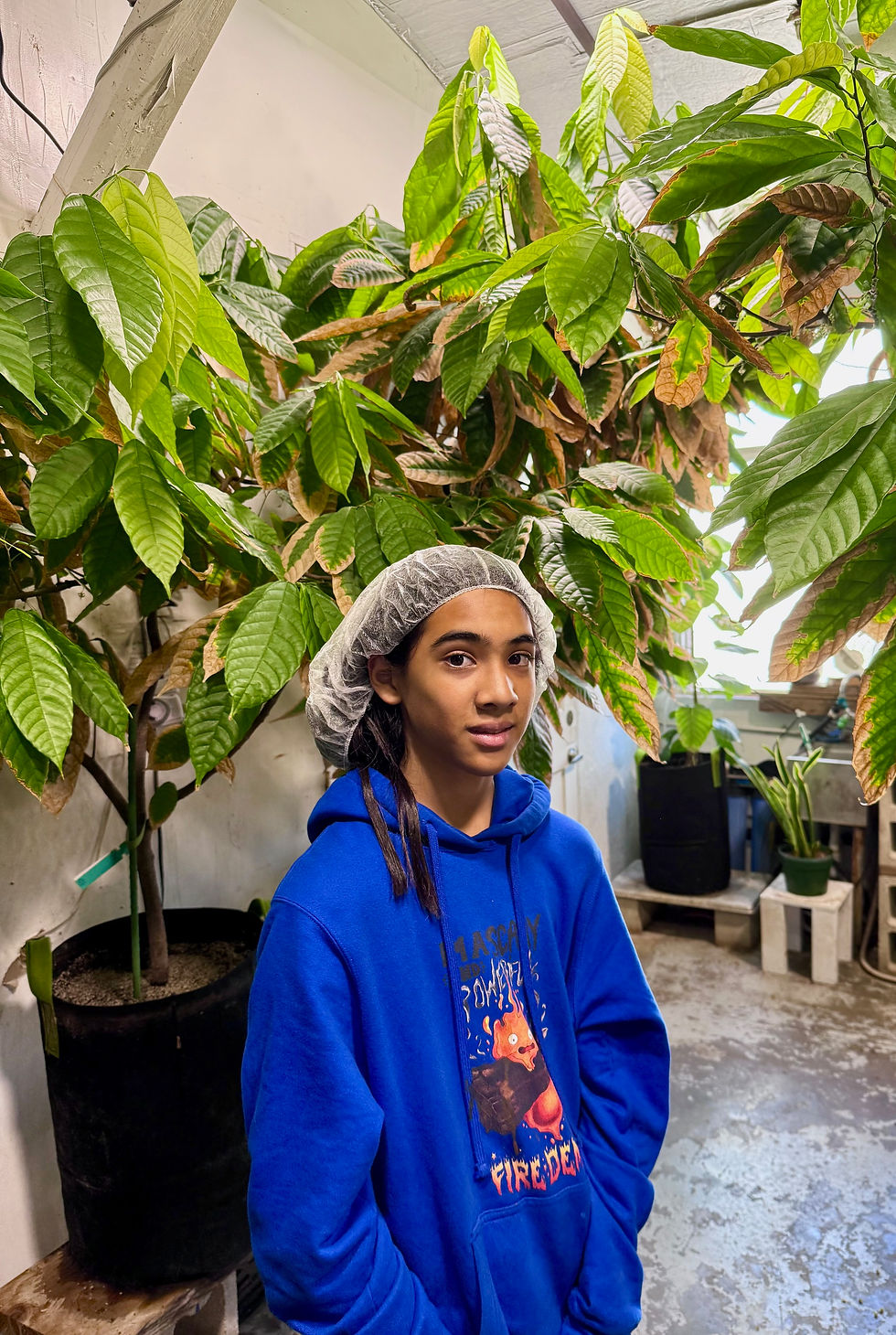The Twenty-Four Blackbirds Unabridged Tour
- Serena

- Oct 12
- 4 min read
Today I took the full tour of Twenty-Four Blackbirds. Once before, I had been there, and taken a short tour. Problem is, Twenty-Four Blackbirds is conveniently located about two hours away from where I live. Anyway, I found a time, and took the tour. There was a very odd discrepancy, which I'll get to.
The first part of the tour was exactly the discrepancy I mentioned. We started at the back of the kitchen and moved to the front. I had been there before, but everyone else on the tour hadn't, and so they were unprepared for 72% humidity levels and 95 F temperates (I apologize for using Fahrenheit, I've had a long day). Admittedly, I was wearing a Howl's Moving Castle hoodie, so perhaps I was unprepared too. Our guide explained that Mike, the owner, hired a plant biologist exclusively for tending a comparatively miniscule.
Now, when one plants cacao in California in general, it's not usually worth it. I mean to say that the potential profit from processing those cotyledons comes nowhere near to offsetting the cost of all the equipment and water and AC. Adding in the fact that Mike also hired a plant biologist, only contributing towards the cost, and one is forced to think that the crop must have some purpose besides the beans. I've got no idea what on earth that could possibly be, but it must be quite a clever solution, because if there's one word that describes that way in which chocolate is made at Twenty-Four Blackbirds, it's "clever". And what was in the next room just goes to show that my evaluation is accurate.
The next room was mostly bean storage, except for one very interesting machine. The beans were stored in (I think) 1-ton sacks. The way they got these in that room was such a simple, eccentric solution that I couldn't help but grin. They just lifted off the wall and drove the truck in. The machine, on the other hand, was an industrial chicken rotisserie roaster, repurposed as a cacao roaster. I guess Mike took one look at the massive, perforated wheel in the roaster, and thought, "Maybe I could change the hole sizing so that heat was distributed evenly throughout beans."
The rest of the tour was your standard chocolate kitchen: a mesh sorter, a single-shot dispenser, a cryogenic freezer that goes down to -40 C...
Pause. That last one.
For the record, I've never thought about preserving chocolate by freezing it to such a temperature that water literally could not last for an instant. This is a perfectly valid strategy, and it's just a matter of putting the chocolates in and closing the top. The freezer freezes the water in mere microseconds, which ensures that the chocolate cannot degrade. It's extremely simple, yet effective in the extreme. Storing chocolate in this way basically makes it so that it can never bloom. This is mind-boggling to me, since I only know of two foods that are technically edible no matter how old, and those are honey (for reasons I would rather not explain because they require me to delve into chemistry and other science-y stuff, and frankly, because I'm not entirely sure I know, but let's stick to the excuse "I'm tired") and salt (because it's the only thing humans actively and purposefully consume that was not once living), so adding another onto the list, although technical, is exciting.
The tour ended with a tasting, and among the tasting pieces, there was a chocolate-covered espresso bean. I unwisely chose to eat it, which would not have been so bad if I hadn't be about to take another 2-hour drive back to where I live in LA. A poor choice, but the tour required me to think so hard about the crop and the freezer that the extra energy was needed. All in all, an experience worth the four and a half hours of travel.

This is me next to the chocolates and the bars. There are a few bars not pictured, but I would expect anyone's view to be drawn to my Calcifer hoodie (favorite anime character, fight me).

This is me with a few of the trees in the microcrop. Again, I truly have no idea why anyone would consider this worth the investment, but there must be some reason, since Mike is a really clever guy. One must consider also that Twenty-Four Blackbirds processes a relatively small amount of chocolate, but still hundreds of thousands of pounds of nibs per year, and this crop will produce maybe twenty pounds of nibs per year. That's like comparing (prepare yourself for a potentially horribly inaccurate simile) my hoodie to the entire inventory of all of the Macy's in California. There's just no comparison for that kind of scale. Again, I apologize if my figures are inaccurate.

This is the tasting menu. Like a fool, I started from the right, thinking that the higher percentages would overwhelm my palate, and going from the right would ensure that I tasted the 100% last. Everyone else tasted from the left like a normal person.



Wow! This was so interesting and very educational. Thank you, Serena!